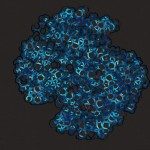Lien vers Pubmed [PMID] – 20008066
J. Bacteriol. 2010 Feb;192(4):1075-87
Proteins that bind sigma factors typically attenuate the function of the sigma factor by restricting its access to the RNA polymerase (RNAP) core enzyme. An exception to this general rule is the Crl protein that binds the stationary-phase sigma factor sigma(S) (RpoS) and enhances its affinity for the RNAP core enzyme, thereby increasing expression of sigma(S)-dependent genes. Analyses of sequenced bacterial genomes revealed that crl is less widespread and less conserved at the sequence level than rpoS. Seventeen residues are conserved in all members of the Crl family. Site-directed mutagenesis of the crl gene from Salmonella enterica serovar Typhimurium and complementation of a Deltacrl mutant of Salmonella indicated that substitution of the conserved residues Y22, F53, W56, and W82 decreased Crl activity. This conclusion was further confirmed by promoter binding and abortive transcription assays. We also used a bacterial two-hybrid system (BACTH) to show that the four substitutions in Crl abolish Crl-sigma(S) interaction and that residues 1 to 71 in sigma(S) are dispensable for Crl binding. In Escherichia coli, it has been reported that Crl also interacts with the ferric uptake regulator Fur and that Fur represses crl transcription. However, the Salmonella Crl and Fur proteins did not interact in the BACTH system. In addition, a fur mutation did not have any significant effect on the expression level of Crl in Salmonella. These results suggest that the relationship between Crl and Fur is different in Salmonella and E. coli.

